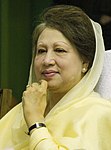February 1996 Bangladeshi general election
| |||||||||||||||||||
300 of the 330 seats in the Jatiya Sangsad 151 seats needed for a majority | |||||||||||||||||||
|---|---|---|---|---|---|---|---|---|---|---|---|---|---|---|---|---|---|---|---|
| Registered | 56,149,182 | ||||||||||||||||||
| Turnout | 21% | ||||||||||||||||||
| |||||||||||||||||||
| |||||||||||||||||||
| This article is part of a series on the |
| Politics of the People's Republic of Bangladesh |
|---|
 |
|
|
|
|
General elections were held in Bangladesh on 15 February 1996. They were boycotted by most opposition parties, and saw voter turnout drop to just 21%.[1] The result was a victory for the Bangladesh Nationalist Party (BNP), which won 278 of the 300 directly elected seats.[1] This administration was short-lived, however, only lasting 12 days[2] before the installation of caretaker government and fresh elections held in June.
Background[edit]
In March 1994, controversy over a parliamentary by-election, which the Bangladesh Awami League-led opposition claimed the BNP government had rigged, led to an indefinite boycott of Parliament by the entire opposition.[3] The opposition also began a program of repeated general strikes to press its demand that Khaleda Zia's government resign and that a caretaker government supervise a general election.[3] Efforts to mediate the dispute, under the auspices of the Commonwealth Secretariat, failed. After another attempt at a negotiated settlement failed narrowly in late December 1994, the opposition resigned en masse from Parliament. The opposition then continued a campaign of marches, demonstrations, and strikes in an effort to force the government to resign.[3] The opposition, including the Awami League's Sheikh Hasina, Jatiya Party and Bangladesh Jamaat-e-Islami pledged to boycott national elections scheduled for 15 February 1996.
Results[edit]
Incumbent Prime Minister Khaleda Zia's BNP was re-elected for the second term after a landslide victory, but in voting boycotted and denounced as unfair by the three main opposition parties. The voter turnout was the lowest in Bangladesh's parliamentary electoral history at only 21%.[1] Following the election, the President invited Zia to form a government, but this administration was short-lived, lasting only 12 days.[2]
 | ||||||||
|---|---|---|---|---|---|---|---|---|
| Party | Votes | % | Seats | |||||
| General | Reserved | Total | +/– | |||||
| Bangladesh Nationalist Party | 278 | 30 | 308 | +140 | ||||
| Bangladesh Freedom Party | 1 | 0 | 1 | 0 | ||||
| Independents | 10 | 0 | 10 | +7 | ||||
| Vacant | 11 | 0 | 11 | – | ||||
| Total | 300 | 30 | 330 | 0 | ||||
| Total votes | 11,776,481 | – | ||||||
| Registered voters/turnout | 56,149,182 | 20.97 | ||||||
| Source: Nohlen et al., Kumar Panday | ||||||||
Aftermath[edit]
An immediate series of hartals (strikes) were called by the other parties and an indefinite non-cooperation movement was conducted until demands for a new, free election was met.[3] In March 1996, following escalating political turmoil, the sitting Parliament enacted the thirteenth Constitutional amendment installing a neutral caretaker government to assume power and conduct new parliamentary elections; former Chief Justice Muhammad Habibur Rahman was named Chief Advisor (a position equivalent to prime minister) in the interim government. Zia's administration lasted only 12 days.[2] New parliamentary elections were scheduled for June 1996.
References[edit]
- ^ a b c Dieter Nohlen, Florian Grotz & Christof Hartmann (2001) Elections in Asia: A data handbook, Volume I, p525 ISBN 0-19-924958-X
- ^ a b c "Tenure of All Parliaments". 12 August 2018. Archived from the original on 12 August 2018. Retrieved 27 December 2018.
- ^ a b c d Islam, Syed Serajul (2001). "Elections and politics in post-Ershad era in Bangladesh" (PDF). Asian and African Studies. 10 (1): 160–173. Retrieved 30 December 2018.




